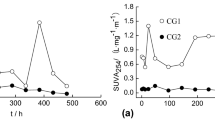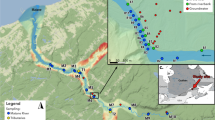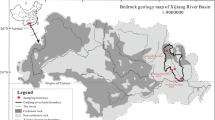Abstract
Drainage from coal mines, where carbonate dissolution is driven by sulfuric acid, can result in a net transfer of geologically-bound carbon to the atmosphere. The flux and downstream evolution of dissolved inorganic carbon (DIC) is presented for two coal mine sites that discharge high concentrations of DIC (3.7–4.5 mM C) producing a total flux of DIC from the mine from 13 to 249 kg-C/year (18–364 metric tons of CO2/year). More than 65 % of the total DIC is lost via CO2 evasion with the remaining DIC is exported downstream as dissolved species. The fate of the DIC depends upon the pH of the water which is controlled by evasion of CO2, the concentration of pre-existing alkalinity, carbonate precipitation and dissolution, and metal hydrolysis reactions. The CO2 concentrations and fluxes from the study sites are comparable to those estimated from literature data for other coal mine sites in the Appalachian region. The total flux estimated from a dataset of 140 coal mines was comparable in magnitude to the CO2 emissions from a small coal-fired power plant. The extent of CO2 degassing from mine waters is poorly constrained because (1) flux estimates can be biased low when acid waters are excluded in alkalinity-based estimates; (2) flux estimates can be biased high if non-carbonate alkalinity is present in the mine waters; and (3) mine waters react rapidly following discharge hampering the measurement process. The study sites presented illustrate the impact of coal mining as an anthropogenic influence on carbon cycling; however, more data are necessary to fully estimate the importance of this impact on regional scales.







Similar content being viewed by others
References
Adams JP (2012) The geochemistry and CO2 flux of two mine discharges, Allegheny County Pennsylvania. Masters thesis, West Virginia University
Allison JD, Brown DS, Novo-Gradac K (1991) MINTEQA2/PRODEFA2, a geochemical assessment model for environmental systems
Anton Paar GmbH (2010) Instruction manual for CarboQC lab and at-line beverage carbonation meter. Document number: C26IB02I. Anton Paar, Graz, Austria, pp 67
Atekwana EA, Fonyuy EW (2009) Dissolved inorganic carbon concentrations and stable carbon isotope ratios in streams polluted by variable amounts of acid mine drainage. J Hydro 372:136–148
Buchanan TJ, Somers WP (1969) Discharge measurements at gaging stations. In: US Geological Survey Techniques of Water-Resources Investigations. Washington, DC
Butman D, Raymond PA (2011) Significant efflux of carbon dioxide from streams and rivers in the United States. Nature Geosci 4:839–842
Calmels D, Gaillardet J, Brenot A, France-Lanord C (2007) Sustained sulfide oxidation by physical erosion processes in the Mackenzie River basin: climatic perspectives. Geology 35:1003–1006
Capo RC, Winters WR, Weaver TJ, Stafford SL, Hedin RS, Stewart BW (2000) Hydrogeologic and geochemical evolution of deep mine discharges, Irwin Syncline, Pennsylvania. In: Proceedings of the 21st West Virginia Surface Mine Task Force Symposium, Morgantown, WV, April 3–4 2000, pp 144–153
Cravotta CA III (2007) Passive aerobic treatment of net-alkaline, iron-laden drainage from a flooded underground anthracite mine, Pennsylvania, USA. Min Water Environ 26:128–149
Cravotta CA III (2008) Dissolved metals and associated constituents in abandoned coal-mine discharges, Pennsylvania, USA: 1. Constituent quantities and correlations. Appl Geochem 23:166–202
Cravotta CA III, Trahan MK (1999) Limestone drains to increase pH and remove dissolved metals from acidic mine drainage. Appl Geochem 14:581–606
Fonyuy EW, Atekwana EA (2008a) Effects of acid mine drainage on dissolved inorganic carbon and stable carbon isotopes in receiving streams. Appl Geochem 23:743–764
Fonyuy EW, Atekwana EA (2008b) Dissolved inorganic carbon evolution and stable carbon isotope fractionation in acid mine drainage contaminated streams: insights from a laboratory study. Appl Geochem 23:2634–2648
Geroni JN, Cravotta CA III, Sapsford DJ (2012) Evolution of the chemistry of Fe bearing waters during CO2 degassing. Appl Geochem 27:2335–2347
Hennen RV (1912) Doddridge and Harrison Counties. WV Geological Survey, Wheeling
Hercod DJ, Brady PV, Gregory RT (1998) Catchment-scale coupling between pyrite oxidation and calcite weathering. Chem Geol 151:259–276
Keating EH, Fessenden J, Kanjorski N, Koning DJ, Pawar R (2010) The impact of CO2on shallow groundwater chemistry: observations at a natural analog site and implications for carbon sequestration. Environ Earth Sci 60:521–536
Kharaka Y, Thordsen J, Kakouros E, Ambats G, Herkelrath W, Beers S, Birkholzer J, Apps J, Spycher N, Zheng L, Trautz R, Rauch H, Gullickson K (2010) Changes in the chemistry of shallow groundwater related to the 2008 injection of CO2 at the ZERT field site, Bozeman, Montana. Environ Earth Sci 60:273–284
Kirby CS, Cravotta CA III (2005) Net alkalinity and net acidity 2: practical considerations. Appl Geochem 20:1941–1964
Kirby CS, Dennis A, Kahler A (2009) Aeration to degas CO2, increase pH, and increase iron oxidation rates for efficient treatment of net alkaline mine drainage. Appl Geochem 24:1175–1184
Lerman A, Wu L (2006) CO2 and sulfuric acid controls of weathering and river water composition. J Geochem Explor 88:427–430
Lorah MM, Herman JS (1988) The chemical evolution of a travertine-depositing stream: geochemical processes and mass transfer reactions. Water Resour Res 24:1541–1552
Millot R, Jé Gaillardet, Dupré B, Allègre CJ (2003) Northern latitude chemical weathering rates: clues from the Mackenzie River Basin, Canada. Geochim Cosmochim Acta 67:1305–1329
Palmer AN (2007) Cave Geology. Cave Books, Dayton
Parkhurst DL, Appelo CAJ (1999) User’s guide to PHREEQC (Version 2)—a computer program for speciation, batch-reaction, one-dimensional transport, and inverse geochemical calculations, US Geological Survey Water Resources Investigation Report 99-4259
Pullman-Swindell (1977) Irwin Syncline Basin Mine Drainage Pollution Abatement Project, Operation Scarlift. Prepared for the PA Department of Environmental Resources, Pittsburgh
Raymond PA, Oh N-H (2009) Long term changes of chemical weathering products in rivers heavily impacted from acid mine drainage: insights on the impact of coal mining on regional and global carbon and sulfur budgets. Earth Planet Sci Lett 284:50–56
Regnier P, Friedlingstein P, Ciais P, Mackenzie FT, Gruber N, Janssens IA, Laruelle GG, Lauerwald R, Luyssaert S, Andersson AJ, Arndt S, Arnosti C, Borges AV, Dale AW, Gallego-Sala A, Godderis Y, Goossens N, Hartmann J, Heinze C, Ilyina T, Joos F, LaRowe DE, Leifeld J, Meysman FJR, Munhoven G, Raymond PA, Spahni R, Suntharalingam P, Thullner M (2013) Anthropogenic perturbation of the carbon fluxes from land to ocean. Nature Geosci 6:597–607
Rice KC, Herman JS (2012) Acidification of Earth: an assessment across mechanisms and scales. Appl Geochem 27:1–14
Sharma S, Sack A, Adams JP, Vesper DJ, Capo RC, Hartsock A, Edenborn HM (2013) Isotopic evidence of enhanced carbonate dissolution at a coal mine drainage site in Allegheny County, Pennsylvania, USA. Appl Geochem 29:32–42
Skousen J, Simmons J, McDonald L, Ziemkiewicz P (2002) Acid-base accounting to predict post-mining drainage quality on surface mines. J Environ Qual 31:2034–2044
Stookey LL (1970) Ferrozine - A new spectrophotometric reagent for iron. Anal Chem 42(7):779–781
Stumm W, Morgan JJ (1996) Aquatic chemistry, chemical equilibria and rates in natural waters, 3rd edn. John Wiley & Sons, New York
Telmer K, Veizer J (1999) Carbon fluxes, pCO2 and substrate weathering in a large northern river basin, Canada: carbon isotope perspectives. Chem Geol 159:61–86
USEPA Air Markets Program Data (2014) http://www.epa.gov/ampd. Accessed 10 Sept 2015
USGS National Water Information System (2014) USGS 01540500 Susquehanna River at Danville, PA. http://waterdata.usgs.gov/nwis/uv/?site_no=01540500&agency_cd=USGS
Vesper DJ, Edenborn HM (2012) Determination of free CO2 in emergent groundwaters using a commercial beverage carbonation meter. J Hydro 438–439:148–155
Vesper DJ, Edenborn HM, Billings AA, Moore JE (2015) A field-based method for determination of dissolved inorganic carbon in water based on CO2 and carbonate equilibria. Water Air Soil Pollut 226:28
Waychunas GA, Kim CS, Banfield JF (2005) Nanoparticulate iron oxide minerals in soils and sediments: unique properties and contaminant scavenging mechanisms. J Nanopart Res 7:409–433
Webb JA, Sasowsky ID (1994) The interaction of acid mine drainage with a carbonate terrane: evidence from the Obey River, north-central Tennessee. J Hydro 161:327–346
Younger PL, Banwart SA, Hedin RS (2002) Mine water hydrology, pollution, remediation. Kluwer Academic Publishers, Dordrecht
Zhang DD, Zhang Y, Zhu A, Cheng X (2001) Physical mechanisms of river waterfall tufa (travertine) formation. J Sed Res 71:205–216
Acknowledgments
Thanks to Harry Edenborn for help throughout the project; Jill Riddell for help in collecting field data; to the J.F. Allen Memorial Muzzleloader Range for allowing access to the LRM site; and to John Eleyette of the Guardians of the West Fork for providing background information and facilitating access at the LRM site; and to useful suggestions made by Dr. Charles Cravotta and an anonymous reviewer. This work was performed as part of the National Energy Technology Laboratory’s Regional University Alliance (NETL-RUA), a collaborative initiative of the NETL, under the RES contract DE-FE0004000.
Author information
Authors and Affiliations
Corresponding author
Rights and permissions
About this article
Cite this article
Vesper, D.J., Moore, J.E. & Adams, J.P. Inorganic carbon dynamics and CO2 flux associated with coal-mine drainage sites in Blythedale PA and Lambert WV, USA. Environ Earth Sci 75, 340 (2016). https://doi.org/10.1007/s12665-015-5191-z
Received:
Accepted:
Published:
DOI: https://doi.org/10.1007/s12665-015-5191-z




